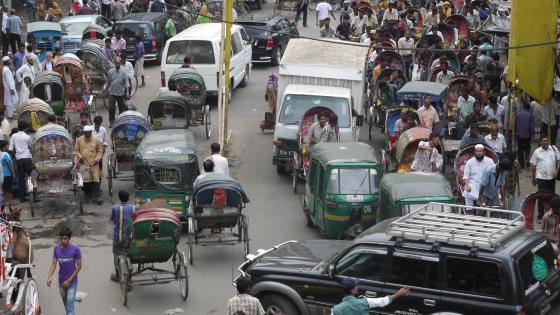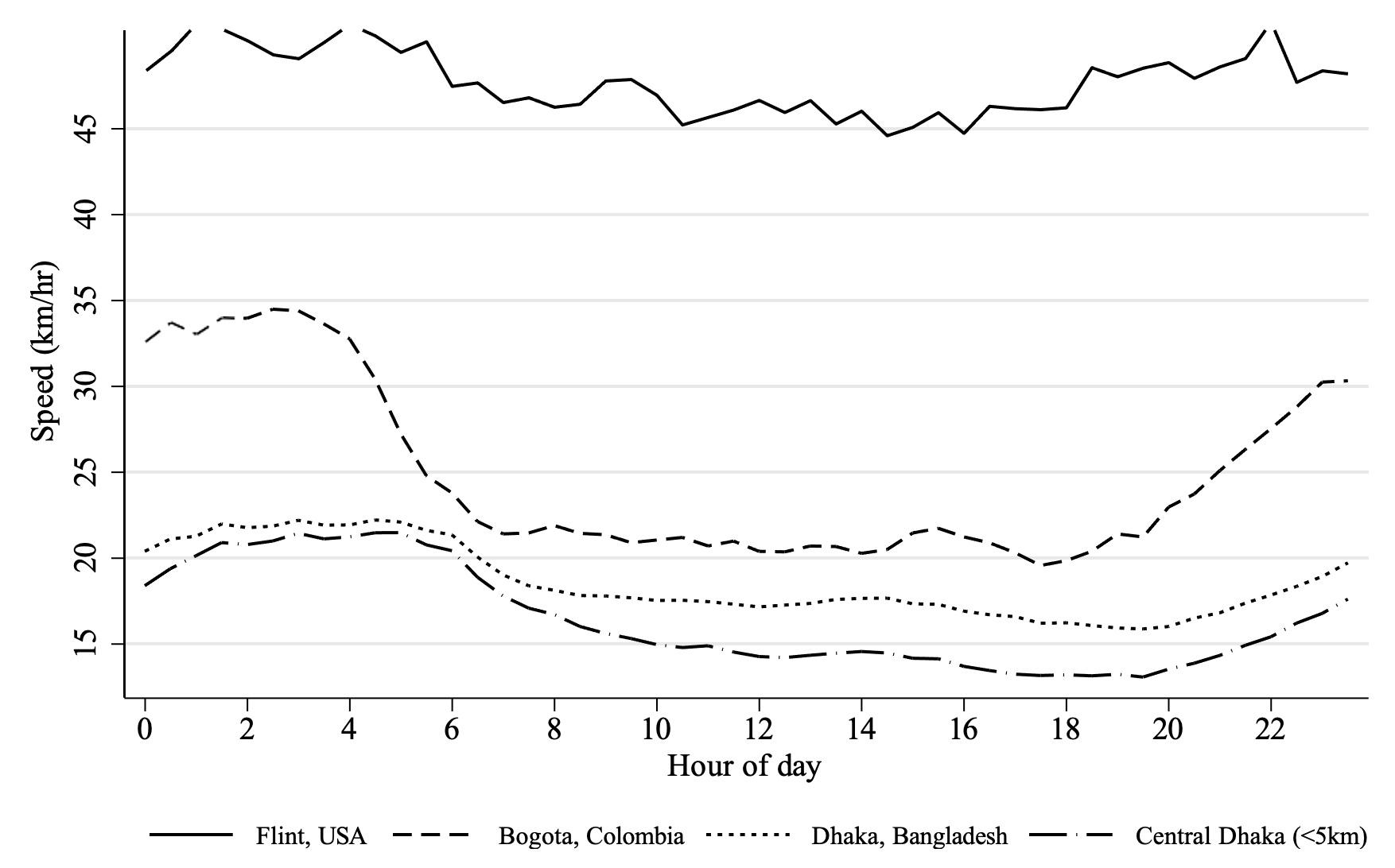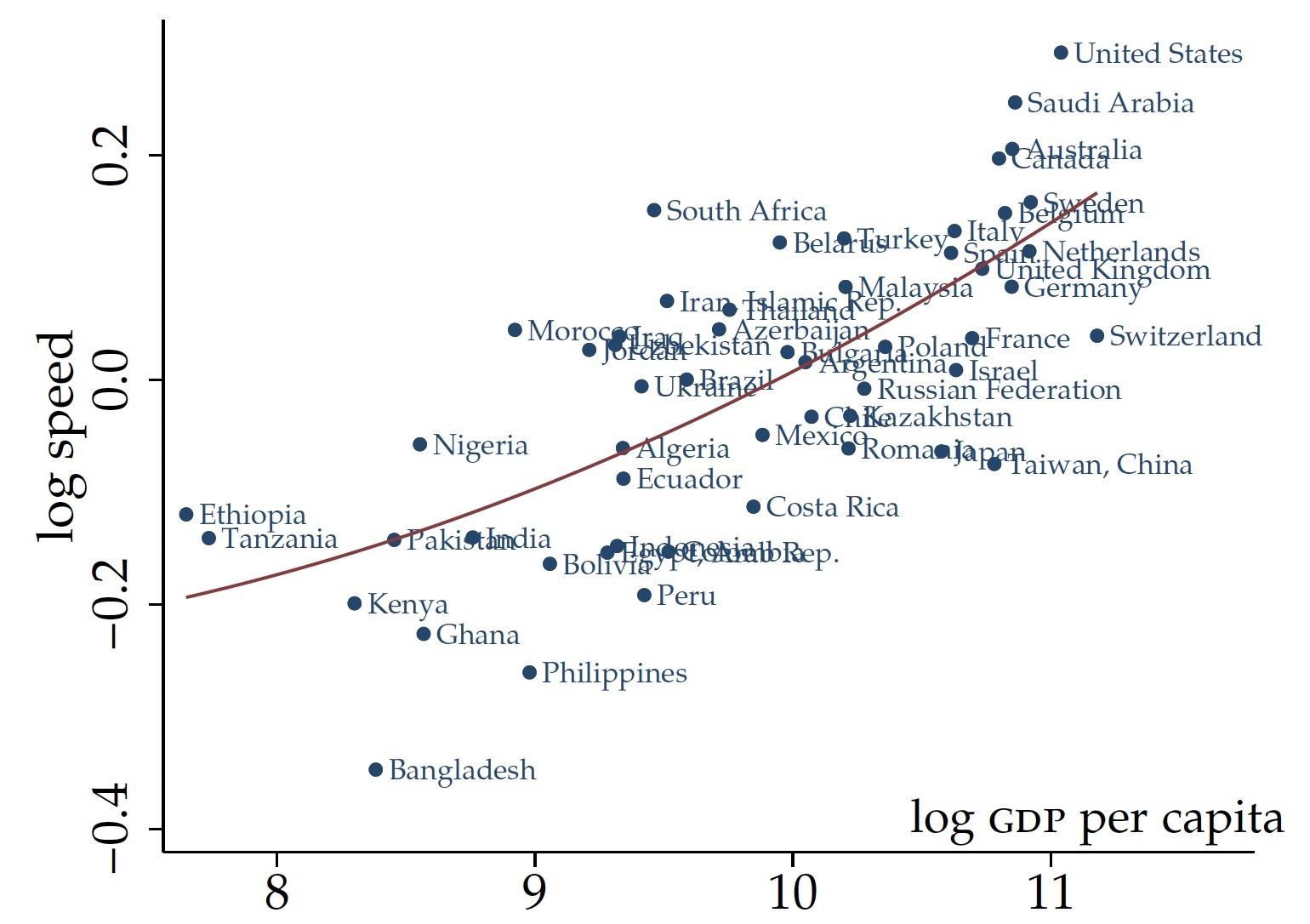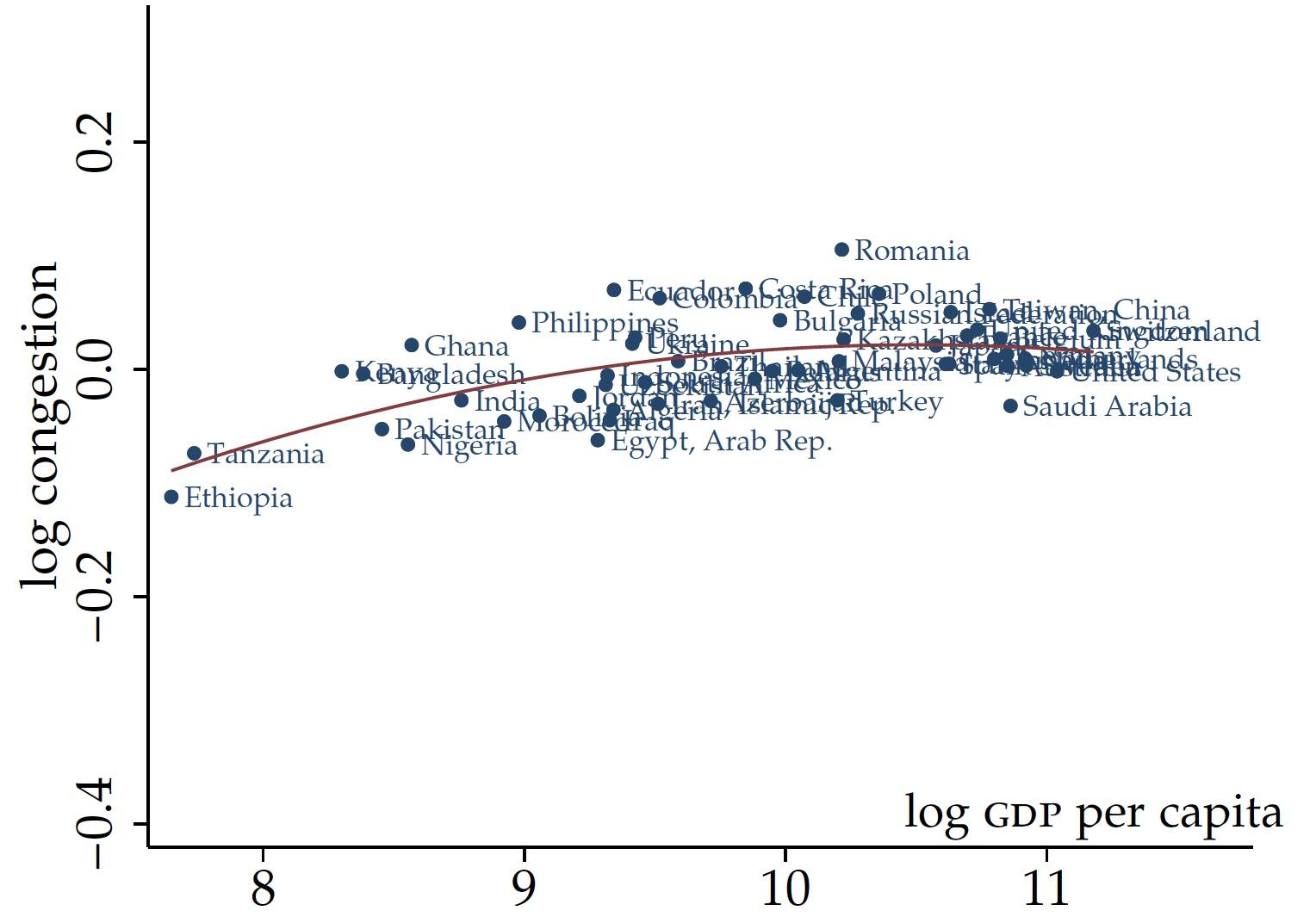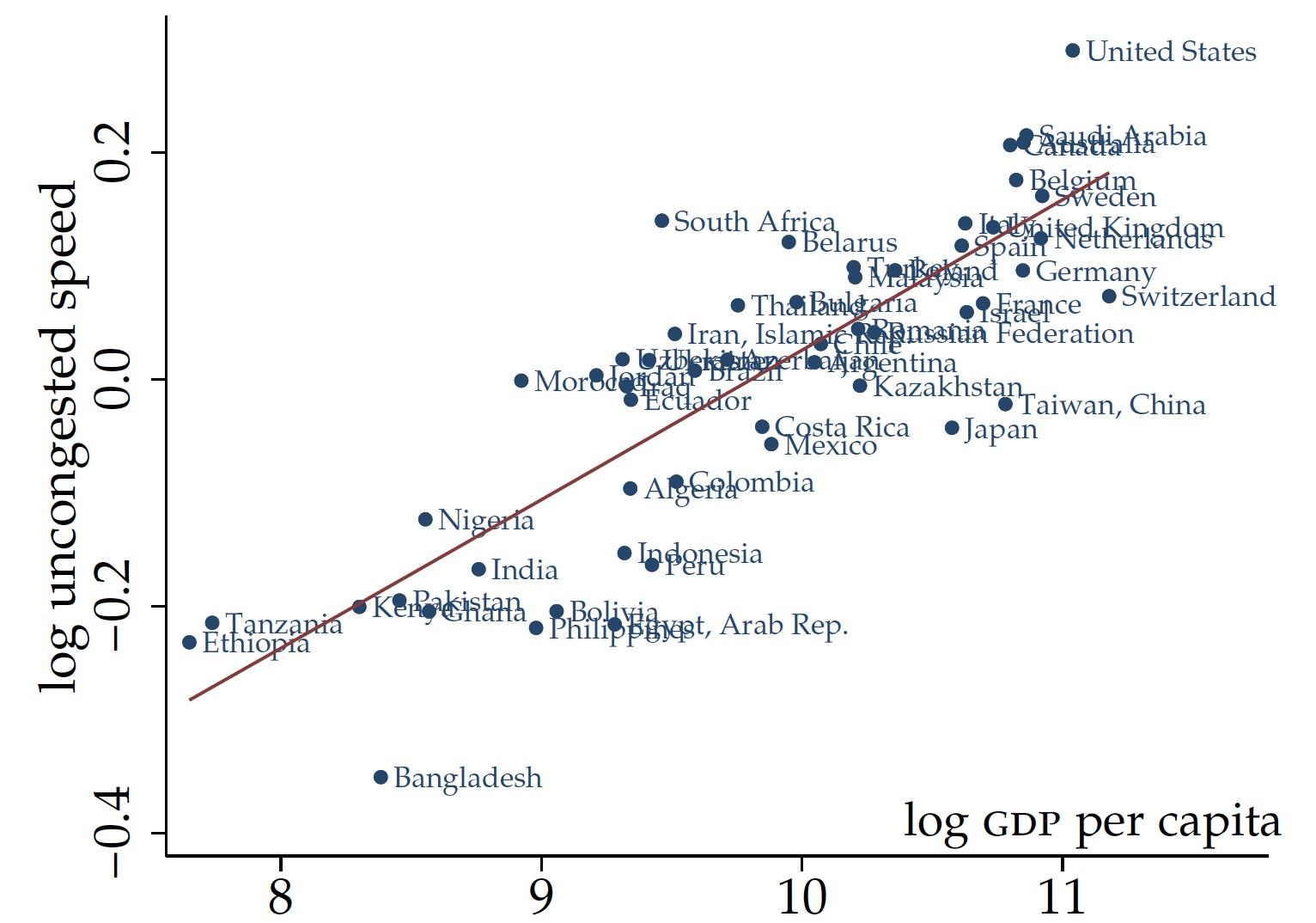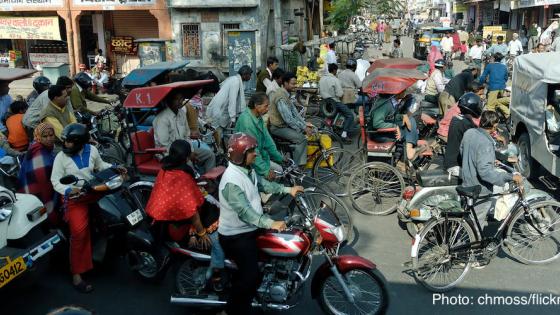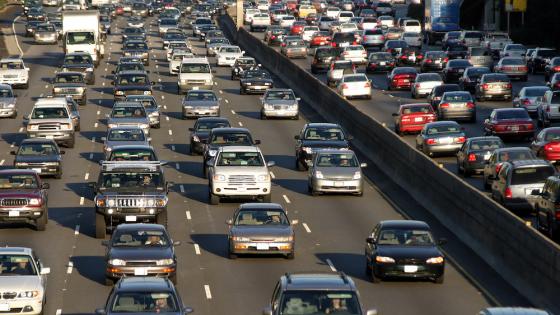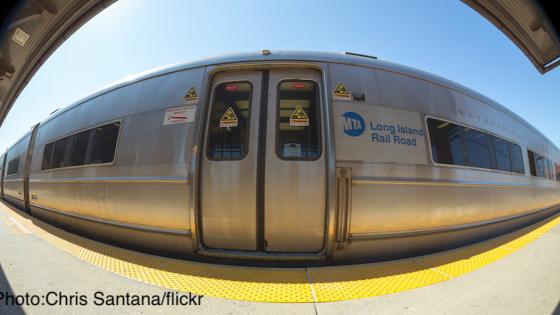Cities exist to facilitate human interactions, by bringing people into closer physical proximity. However, many urban dwellers lack easy access to interaction opportunities, especially if they are poor. They do not live within walking distance of good jobs, good schools, productive peers, and attractive entertainment options. To access such opportunities, most urban dwellers depend on the availability of fast and reliable transportation (Heblich et al. 2020, Glaeser 2020). What determines the ability of an urban transportation system to move people? Why is urban travel fast in some countries and slow in other countries? Does the process of economic development offer hope of better mobility outcomes in poor countries, or only of more congestion?
In our recent paper (Akbar et al. 2023a), we attempt to answer these questions. Using data from a popular navigation app, we assembled a new global database on motor vehicle travel speed in over 1,200 large cities in 152 countries. Figure 1 demonstrates the wide dispersion in travel speed across cities that we document. The figure shows the average speed of travel of motor vehicles throughout the day in three extreme cities. The fastest city (Flint, US) is three times as fast as the slowest city (Dhaka, Bangladesh). The most congested city (Bogota, Colombia) experiences travel speeds that are 50% slower during peak hours that last almost the entire working day.
Figure 1 Travel speed throughout the day: The fast, the slow, and the congested
Note: Mean speed for trips with lengths between 5 and 10 kilometres. Dhaka is the slowest, Flint is the fastest, and Bogota is the most congested city in the world. Central Dhaka refers to trips that take place on average within 5 kilometres of the centre of Dhaka.
Looking at how travel speed varies across countries and cities, we find that, in general, some countries are fast, like the US, and some countries are slow, like Bangladesh. There is less variation in speed within countries. A large share of the speed variation across countries can be explained by national income per capita, suggesting that economic development may play an important role in improving mobility outcomes.
Until now, knowledge about urban transportation in many parts of the world has been mostly speculative and based on anecdotal or scattered evidence (Gwilliam 2003). Although new transportation studies cover an expanding range of cities and countries, including Bangalore (Kreindler 2023) and other Indian cities (Akbar et al. 2023b), Cape Town (Conwell 2023), and Bogotá (Tsivanidis 2019), there is a need for more systematic investigations across cities in many countries. Such cross-country analyses are useful to understand why some transportation systems perform better than others, and necessary to study questions related to economic development. By leveraging new Google micro-data available worldwide, we are able to study transportation outcomes in rich and poor countries representing the full range of incomes, geographies, and urban systems.
Measuring the determinants of urban travel speed
To create a new global transportation database that is comparable across countries, we rely on more than half a billion trips simulated on Google Maps in 2019. Using this information, we calculate city-level speed and congestion indices.
The top panel of Figure 2 illustrates the strong positive relationship between travel speed and GDP per capita for a large cross-section of countries. Cities in the US, the fastest country in the world, are on average twice as fast as cities in Bangladesh, the slowest country. As shown in the middle panel of Figure 2, richer countries are moderately more congested. However, as illustrated in the bottom panel of the same figure, faster uncongested speed more than compensates for higher congestion in richer countries.
Figure 2 Speed, congestion, and uncongested speed versus GDP per capita
Each point in each scatter is a country. In the top panel, the vertical axis position is the mean of our city speed index using Google Maps data from 2019. The vertical axis in the middle panel is the corresponding congestion index, and in the bottom panel, it is the uncongested speed index. The horizontal axis in each panel is 2018 GDP per capita at ppp in 2017 international dollars. The sample is all 54 countries with GDP data and at least three cities in our baseline sample. The trend line in each panel is a quadratic fit.
Our paper shows that a standard urban model can help interpret the link between economic development and mobility. In that model, richer countries invest more in fast roads and have lower population density, because tax revenues to fund the roads and housing consumption both rise with income. Using detailed global data on city characteristics, we can estimate the model to decompose how the size, infrastructure, and topography of the city contribute to explaining why urban travel is faster in richer countries. We find that the length of major roads and the land area of the city explain most of the relationship between speed and GDP per capita. That is, urban travel speed is faster in cities with more major roads and larger land areas, and cities in richer countries have more major roads and larger land areas (van Ommeren et al. 2022). Other characteristics such as the city population and a grid-like road network are important determinants of urban travel speed, but they do not contribute to explaining why richer countries are faster, because they have a small correlation with the country's GDP per capita.
We also show how different characteristics of cities contribute to congestion separately from their contribution to uncongested speed. Perhaps surprisingly, the contribution of the population to slower speed operates primarily through slower uncongested speed, not more congestion. Urban crowding mostly makes travel slower at all times, as vehicles compete for space with pedestrians and other road uses encroaching on traffic in large cities.
More generally, our methodology allows us to investigate the speed of urban travel in any city or country. For example, we show that the US is faster than other rich countries because its cities have lower populations, wider areas, more major roads, and more grid-like road networks. Bangladesh is slower than other poor countries because its cities are crossed by more water bodies, are more populous, and have fewer major roads. Therefore, while road infrastructure is the most important factor explaining why rich countries are faster than poor countries, the population of cities and their land area are most important in explaining why the US is so fast, and topography is most important in explaining why Bangladesh is so slow.
Policy implications
These results have several implications that are relevant for policy. On an optimistic note, we find that the process of economic development generally improves transportation outcomes, as countries build more roads, expand their urban areas, and develop better road construction technology, while incurring only slightly more congestion on average. This implies that policies directed at curbing congestion are unlikely to be effective at closing the gap in speed between rich and poor countries. Building more major roads, even keeping quality constant, would be more impactful, albeit obviously more costly. However, in some contexts, road infrastructure is not the main reason why countries or cities are slow. The ability of Bangladesh to improve urban transportation outcomes is severely constrained by its challenging topography, large urban populations, and limited land area.
More generally, urban policymakers rarely know how their city performs relative to peer cities and why, despite the large monetary and time resources devoted to urban transportation by households and governments. Even in developed countries, travel surveys are only conducted every five to ten years with limited geographic comparability within each country and none outside. Our paper takes a step toward improving the availability of data in transportation. Although our data cannot fully substitute for a traditional travel survey given the lack of information about travellers and their motivation for travelling, they provide detailed information about travel speed and congestion, and their determinants. This data are available at scale, and comparable across cities and countries, and even across different parts of cities. We hope that analyses similar to those described above, tailored to different case studies, can offer policymakers, in poor and rich countries alike, a set of basic facts about the performance of their urban transportation network.
References
Akbar, P A, V Couture, G Duranton and A Storeygard (2023a), “The fast, the slow, and the congested: Urban transportation in rich and poor countries”, University of Pennsylvania.
Akbar, P A, V Couture, G Duranton and A Storeygard (2023b), “Mobility and congestion in urban India”, American Economic Review 113(4): 1083–1111.
Conwell, L (2023), “Subways or minibuses? privatized provision of public transit”, working paper, available at SSRN.
Glaeser, E L (2020), “Infrastructure and urban form”, NBER Working Paper 28287.
Gwilliam, K (2003), “Urban transport in developing countries”, Transport Reviews 23(2): 197–216.
Heblich, S, S J Redding and D M Sturm (2020), “The making of the modern metropolis: Evidence from London”, Quarterly Journal of Economics 135(4): 2059–2133.
Kreindler, G (2023), “Peak-hour road congestion pricing: Experimental evidence and equilibrium implications”, Econometrica, accepted.
Tsivanidis, N (2019), “Evaluating the impact of urban transit infrastructure: Evidence from Bogotá’s Transmilenio”, mimeo, University of California Berkeley.
van Ommeren, J, V M Nielsen, F Ostermeijer and H Koster (2022), “Cars make cities less compact”, VoxEU.org, 8 March.
